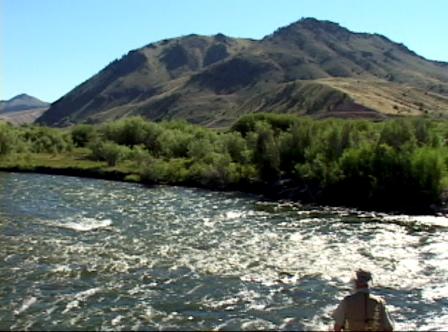
The Beaverhead River Tailwaterstart at the Clark Canyon Dam near Dillon, MT and flows mostly north about 83 miles to Twin Rivers where it is joined by the Ruby River and later with the Big Hole before entering the Jefferson River. It is considered one of the best brown trout fisheries in Montana. The Beaverhead River brown trout will usually average between 12 to 18 inches with some being taken over 20 inches.
The Beaverton consists of two main sections. The upper section which starts at the Clark Canyon Dam is about sixteen miles long before it flows into Barretts Diversion Dam. During this section it twists and turns due to the many hills along its path. The banks are lined with cottonwood and willow trees. The Beaverhead at this point is too deep for good wading; so due to its excellent fly fishing possibilities, there are many float parties along this section.
The Beaverhead below Barretts Dam flows between the Pioneer and Ruby Mountain ranges before reaching Dillon. After leaving Dillon, it flows through a big agricultural valley. Unfortunately, some of the waters in this section are siphoned off to support agriculture making it somewhat difficult to float. However, these waters can be easily waded.
It is important to understand the flows of the river. During late winter and spring the Clark Canyon Reservoir is being filled with water, which causes a somewhat slower current in the river. In summer, cold water is released from the reservoir to support the agriculture, but since it is siphoned off, it can be very low. It is important to check the water levels before you go out to fish.
There are many springs that provide a higher than normal pH which supports a large quantity and variety of aquatic insects making it a fly fishers dream.
The upper section of the Beaverhead stays a lot colder during the summer than the lower sections due to the water being released from reservoir. The water downstream of Barretts Dam will invariably run a little warmer.
Fly Fishing the Beaverhead River:
Fishing the Beaverhead can be very rewarding but at the same time it can be challenging. The trout are tricky and wary because they have survived the experience of heavy fishing pressure. The rapid flow rate can make it difficult to fight the current and make accurate presentations. Further changes in the water conditions contribute to the complexity.
Most anglers prefer to use nymphs or streamers although some anglers will still prefer dry flies. In the upper section, it is preferable to drift a nymph tight against the banks underneath the overhanging willow and cottonwood trees. It is often difficult to get a good presentation to where the big browns are holding while drifting at a rapid pace but it will be rewarding.
Streamers are particularly important during the fall when the brown trout spawn. They become very aggressive and will hit most streamers if they get near them. The browns will be holding deep and it will be difficult to get them to rise to a dry fly. However, sometimes the rainbows will fall prey to a dry fly in the fast flowing waters especially on a bright day. Again, it is important to use the very best fly imitations and we recommend the Perfect Fly line of flies available Here.
Spring:
The water levels may remain high until early June. The Blue-winged Oliver is one of the most important mayfly hatches and they start in March and continue through May. The Skwala Stonefles will be hatching in March and April and offer some excellent fishing as well. The Little Brown Stoneflies will also hatch at the same time. The Mother's Day hatch of Grannom Caddisflies will also produce good results.
Summer:
Starting in or about the middle of June, the Pale Morning Duns will hatch providing one of the better hatches. The Tricos will start to hatch around mid July and continue all summer. Stoneflies like the Yellow Sallies and the Golden Stoneflies will be hatching fro Junt to August as well. For Caddisllies, the Spotted Sedges is probably the most important followed by the Green Sedges in July. Craneflies are most active late in summer as well.
Fall & winter:
The Blue-winged Olives will have their second hatch starting in September and lasting into November and there may be some remaining PMDs around. The October Caddis hatch will occur in September and October as well. Streamers to imitate baitfish and sculpins will work as well if fished deep. Midges often overlooked by anglers will provide year around action when all else is not working. However the flow can get as low as 90 cfs which will force into the deeper runs.

Access to the upper portion of the Beaverhead is good as there are many sites available and the river flows through some public lands. In th elower section, access is more limited as it flows through private land with few designated sites.
Montana Regs. Be sure to check for special regulations.
Hatches have been discussed in the seasons and Perfect Flies are recommended.





